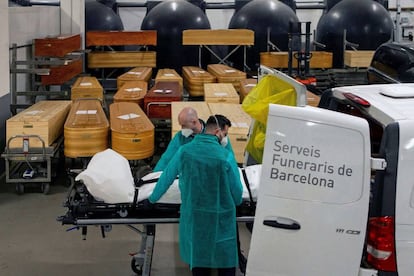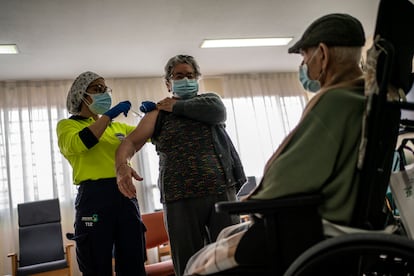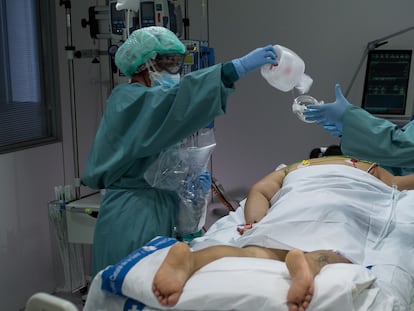The deadly toll of Covid-19 in Spain’s care homes: 29,800 fatalities
Social service residences remain alert amid the third wave of the pandemic, with more than 13,400 cases currently active


Since the end of 2020, Spain has seen both the rollout of the coronavirus vaccination drive and a spike in new infections. This has meant that residents of the country’s care homes – which have been hardest hit by the virus – have not escaped the impact of the third wave, even though they are in the first priority group for vaccination.
A total of 29,757 people in Spain have died in social service residences due to the coronavirus or with compatible symptoms, between the beginning of the pandemic and the end of January, according to figures supplied by Spain’s regions. This figure includes care homes for seniors and also those for people with disabilities.
This is a disaster. We should have saved the vaccination plan, not ChristmasManuel Franco, spokesperson of the Spanish Society of Public Health and Health Administration
But there is no centralized data on the number of deaths in these centers. The Spanish government has so far only released a report, dated June 23, that found that 20,268 people had died in social service residences due to the coronavirus or with compatible symptoms. It is also not known how many of these victims lived in senior homes, although it is likely that they make up the majority given that these centers have been one of the biggest hotspots for infection.
Given the lack of centralized data, regional figures must be used. However, it is difficult to compare these numbers as the regions have different ways of counting deaths in residences. Asturias, Madrid and Castilla y León, for example, do not differentiate between victims in care homes for people with disabilities and senior residences. Indeed in Madrid, it is impossible to know the real number of fatalities as the region only counts victims who died at their care home – not those who died in the hospital.
But the evolution of the pandemic in social service residence can be gauged by the overall figures. In the middle of November, when Spain was grappling with the second wave of the pandemic, EL PAÍS requested data from the regions on the number of Covid-19-related deaths in care homes. Between then and January 27, the closest date of the updated figures, 5,224 residents have died, according to regional data. This represents 26% of all Covid-19-related fatalities reported in Spain in this time period.
“We’ve paid a high price for Christmas,” says Susana Ruiz, a board member of Lares Federation, an industry group that represents around 1,000 residences run by non-profit groups. But according to Ruiz, the impact of the third wave has not been as great as the first, “which caught us without personal protective equipment, tests or even an understanding about how the virus worked.” Back then, she notes, the protocols in place also resulted in restrictions on sending ill residents to the hospital in overstretched regions. These days, everyone who needs medical assistance is receiving it, say industry sources, and there is better diagnosis capability.
We had more deaths in January than in December, and more infectionsAndrés Rueda, spokesperson of the Association of Social Service Directors and Managers
While there is no centralized data for the whole of Spain, figures from regions such as Asturias highlight the difference between the first and third waves of the pandemic. In the first, 32% of all confirmed coronavirus infections were diagnosed in social service residences, and of these cases, 67% died. Fatalities in care homes represented 34% of the total death toll. In the third wave, based on data from January 1 to 25, these figures have dropped significantly: residents now account for 4.2% of all confirmed infections and 40% of all deaths. Of the coronavirus cases detected in care homes in this period, 8% have died.
But the third wave of the pandemic continues to take a deadly toll on Spain’s social service residences. “We had more deaths in January than in December, and more infections,” says Andrés Rueda, the spokesperson of the Association of Social Service Directors and Managers. “When the virus enters, it continues to be devastating.” Infections spread quickly, he explains, as it is impossible for workers and residents to respect social distancing rules.
Jesús Molina Cabrilla, a specialist in preventive medicine, agrees: “Although we make it difficult for the virus to enter, once it does, it’s where it causes the most harm: it is very easy for it to spread because these are closed institutions that are home to the most vulnerable people.”
One month after the launch of Spain’s vaccination drive, there are 13,848 active coronavirus infections in social security residences, according to regional data. This situation is particularly concerning in Valencia, the region with the highest 14-day cumulative number of cases per 100,000 inhabitants, where there are 4,636 active cases – nearly a third of the total. This spike in infections is corroborated by the Spanish Health Ministry, which does provide centralized figures on the number of new cases linked to outbreaks. On December 18, it recorded 740 positive cases from 56 outbreaks. By January 29, these figures had jumped 134.5%, with 1,735 infections from 128 outbreaks reported.
Vaccination drive
Under Spain’s guidelines, the first priority group for vaccination is residents of care homes, medical workers and all adults with need for daily assistance even if they are not in residential care. Epidemiologist Manuel Franco, the spokesperson of the Spanish Society of Public Health and Health Administration, believes that this will be “key” to fighting the third wave of the pandemic.

“When you have such tremendous community transmission, it is easy for the virus to enter anywhere: the home, the workplace, in schools, and as a result, in senior residences, no matter how much visits in and out of the center are restricted,” he says. Franco is worried about the impact of the third wave, which is attributed to the relaxation of restrictions over the Christmas period. Although the second dose of the vaccine has begun to be rolled out, coronavirus cases continue to rise. “This is a disaster. We should have saved the vaccination plan, not Christmas,” says Franco.
In some social service residences, the vaccination drive has not even begun due to coronavirus outbreaks. In other cases, centers have recorded new infections after the first dose was administered to residents. Ignacio Fernández, the president of FED, an association that represents 2,000 care homes, admits that it is “a dangerous time,” explaining that centers are waiting desperately for the arrival of the second dose.
While most regions have administered the first dose, some, such as the Canary Islands and Murcia, have already administered the second. According to preliminary data from Israel, a single dose of the Pfizer-BioNTech vaccine provides some protection from the virus, and early studies from the Catalan government also show that the first jab can have an effect 10 days after it is administered.
For care homes, the coronavirus vaccine is the light at the end of the tunnel. Jesús Cubero, the secretary general of Aeste, an industry group that represents 400 centers, explains: “From the beginning of March, we might be the only safe centers in Spain. Without letting our guard down, we have to prioritize the emotional wellbeing of the seniors, we have to start opening residences and allowing visits again.”
English version by Melissa Kitson.
Tu suscripción se está usando en otro dispositivo
¿Quieres añadir otro usuario a tu suscripción?
Si continúas leyendo en este dispositivo, no se podrá leer en el otro.
FlechaTu suscripción se está usando en otro dispositivo y solo puedes acceder a EL PAÍS desde un dispositivo a la vez.
Si quieres compartir tu cuenta, cambia tu suscripción a la modalidad Premium, así podrás añadir otro usuario. Cada uno accederá con su propia cuenta de email, lo que os permitirá personalizar vuestra experiencia en EL PAÍS.
¿Tienes una suscripción de empresa? Accede aquí para contratar más cuentas.
En el caso de no saber quién está usando tu cuenta, te recomendamos cambiar tu contraseña aquí.
Si decides continuar compartiendo tu cuenta, este mensaje se mostrará en tu dispositivo y en el de la otra persona que está usando tu cuenta de forma indefinida, afectando a tu experiencia de lectura. Puedes consultar aquí los términos y condiciones de la suscripción digital.
More information
Últimas noticias
Welcome to the post-religion era: The idea of Christianity as the absolute truth has become obsolete
‘I thought you would like it’: The risky sexual practice popularized by TV shows and TikTok
The digitalization of tourism: ‘They promise experiences and gave us the worst possible one’
Mexican peso defies uncertainty with forecasts of a new period of stability in 2026
Most viewed
- Sinaloa Cartel war is taking its toll on Los Chapitos
- Oona Chaplin: ‘I told James Cameron that I was living in a treehouse and starting a permaculture project with a friend’
- Reinhard Genzel, Nobel laureate in physics: ‘One-minute videos will never give you the truth’
- Why the price of coffee has skyrocketed: from Brazilian plantations to specialty coffee houses
- Silver prices are going crazy: This is what’s fueling the rally










































